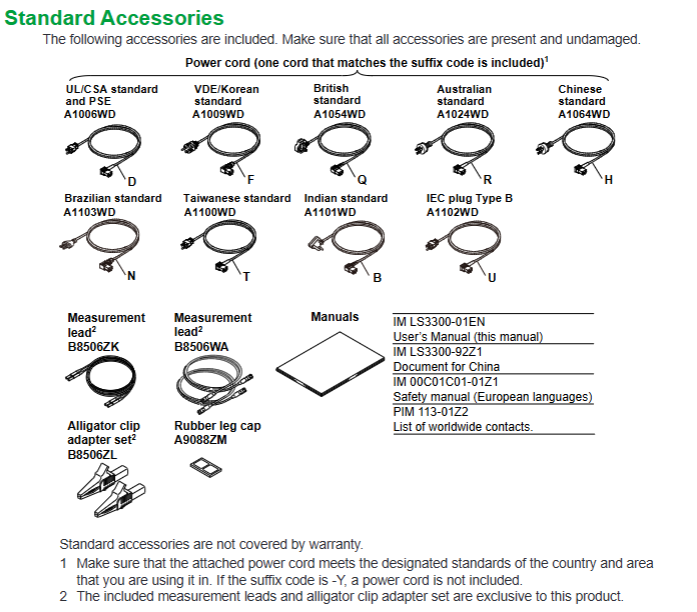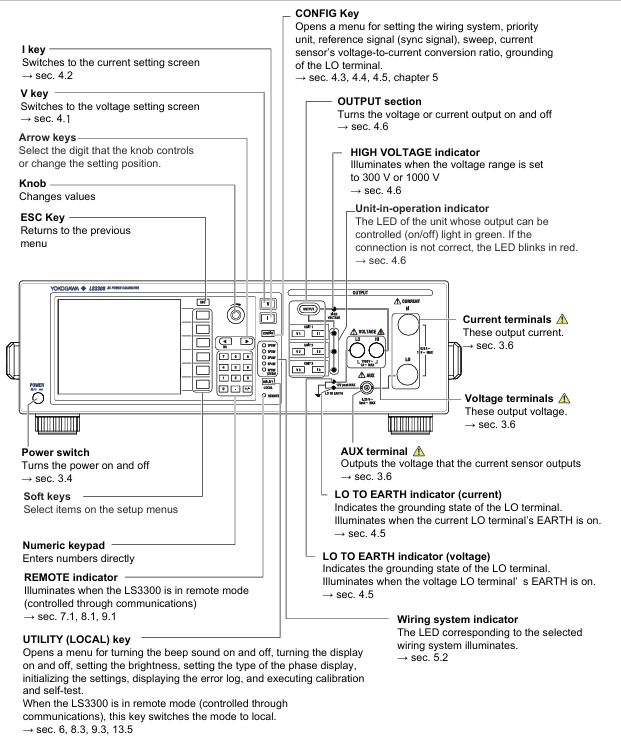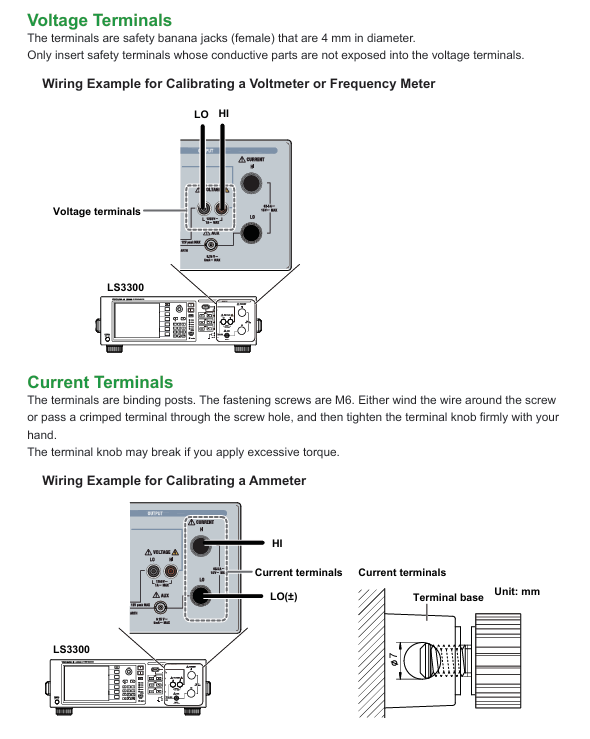

K-WANG


YOKOGAWA LS3300 AC Power Calibrator
YOKOGAWA LS3300 AC Power Calibrator
Product basic information
1. Product positioning and core functions
LS3300 is an AC power calibrator that uses the "phantom load method" to generate AC voltage, current, and power signals. It is mainly used for calibrating power meters and other equipment, supporting multiple wiring systems and synchronous operations to meet calibration needs in different scenarios.
2. Manual system and language version
Supporting manual: In addition to this manual, it also includes Chinese specific documents (IM LS3300-92Z1), European language safety manual (IM 00C01C01-01Z1), and global contact list (PIM 113-01Z2).
Language code: The "EN" in the manual number represents English, and "Z1" represents other languages such as Chinese. Users can obtain the corresponding version according to their needs.
Manual update: The content may change without prior notice due to product performance/feature upgrades. The latest version should refer to the official website; As of April 2025, it is the 8th edition, and the historical version gradually iterates from the 1st edition in August 2017.

Preparation before use
1. Packaging content inspection
Host and identification: Confirm that the host model is LS3300 (specification 1200V, 60A), and verify the model and suffix code through the side panel nameplate to avoid misdelivery.
Standard accessories: including 1 power cord with matching suffix code (such as - H for Chinese standard, - Q for British standard, etc., - Y without power cord needs to be provided), measuring wire (B8506ZK/B8506WA), crocodile clip adapter set, rubber foot cap, and complete manual. Confirm that the accessories are intact.
Optional accessories: Measurement wire, crocodile clip adapter, BNC cable, rack installation kit, etc. need to be purchased separately, and the selection needs to match the rated parameters of the equipment (such as 758917 measurement wire rated 1000V, 32A).
2. Installation and power connection
Installation requirements: It should be installed in a well ventilated area, with sufficient space reserved for the top/bottom air outlet and rear air inlet (top/bottom ≥ 20cm), avoiding direct sunlight, humidity, strong magnetic fields, and other environments; Supports desktop placement (adjustable movable feet) or rack installation (requires specialized kit), and is prohibited for outdoor or water environments.
Power specifications:
Rated voltage: 100-120VAC or 200-240VAC, allowable fluctuation range 90-132VAC, 180-264VAC, frequency 50/60Hz (allowable fluctuation range 48-63Hz).
The power cord must be designed specifically for the device and comply with local standards (such as the - H type used in China, rated at 250V). It must be plugged into a three hole socket with protective grounding. It is prohibited to cut off the grounding wire or use ungrounded extension cords.
Core functions and operations
1. Output parameter settings
(1) Voltage output setting
Range and Range: Supports ranges of 1V, 10V, 30V, 100V, 300V, and 1000V, with an output range of 0-125% of each range (set by "output level x level ratio", level ratio 0-120%). For example, a 10V range can output a maximum of 12.5V.
Key parameters: frequency 40-1200Hz, phase -180 ° to+359.999 °, power factor -1.0 to 1.0 (lead/lag can be set); When the voltage is ≥ 150V, a buzzing warning will be issued, and when the range is ≥ 300V, the "high voltage indicator light" will light up.
(2) Current output setting
Range and Range: The basic range is 30mA, 100mA, 1A, 10A, 50A, and can be extended to 20A, 30A, 100A, 150A when synchronizing multiple devices; Supports "external sensor mode" (500mV/5V output, voltage current conversion ratio needs to be set), with the same output range as the voltage logic (0-125% range).
Key parameters: Frequency, phase, power factor settings should be consistent with voltage. For high current outputs (such as 20A and above), the wiring system should be set to "1P2W (HI Current)" and multiple devices should be synchronized.
(3) Scanning function (Sweep)
Function purpose: By linearly adjusting the level ratio, the output can smoothly change within a specified range (such as checking for meter pointer sticking), supporting separate scanning of voltage/current.
Parameter settings: Scanning range 0-100%/105%/110%/120% (relative to output level), scanning time 8s/16s/32s/64s (time from 0% to 100%), can be set to "UP" or "DOWN", and will automatically hold when reaching the limit value.
2. Synchronous operation and wiring system
(1) Synchronization function
Multi device synchronization: Supports up to 3 LS3300 devices for synchronization, or synchronization with external devices such as 2558A; The master device is connected to the slave device's "OSC INPUT" terminal through the rear "OSC OUTPUT" terminal, synchronizing frequency and phase (external device synchronization only ensures frequency consistency, phase needs to be manually adjusted).
Synchronization settings: Set the master device to "INTernal" and the slave device to "EXTernal"; The "LINE" mode can also be set to synchronize the output with the power frequency.
(2) Wiring system
Supports 6 types of wiring systems, which need to be selected according to the calibration scenario. Different systems correspond to different device connection methods:
The number of devices required for the applicable scenarios of the wiring system
Single phase two-wire (1P2W) independent calibration of one device
Single phase two-wire (1P2W HI Current) high current output (20A and above) 2-3 units
Calibration of 2 single-phase three wire (1P3W) single-phase three wire systems
Three phase three wire (3P3W) calibration of two three-phase three wire systems
Three phase three wire (3V3A) three-phase three wire (three voltage three current method) calibration for 3 units
Three sets of three-phase four wire (3P4W) three-phase four wire system calibration
3. Other functions
Beeming control: Beeming can be turned on/off (such as voltage ≥ 150V, scan hold, etc.), but it cannot be turned off due to equipment failure (such as fan stoppage, overheating).
Display settings: Supports LCD screen off (wake up by pressing any key), brightness adjustment (0-10 levels), phase display is divided into Type1 (0 ° to the right) and Type2 (0 ° to the top).
Error log: Record error codes that occur during device operation (such as E.030 amplitude control error), clear after power failure, and can be viewed or cleared through the "UTILITY" menu.
Initialization: The device settings can be restored to factory default (except GP-IB and Ethernet settings), and in synchronous mode, the master device initialization will synchronize with the slave devices.

Communication interface
1. Interface type and specifications
The device supports three interfaces: USB, Ethernet, and GP-IB, which cannot be used simultaneously. Configuration needs to be switched through the "CONFIG" menu:
Interface type, specification parameters, purpose
USB 2.0 (HS/FS mode), supports USB-TMC protocol, connects to PC via Type B interface, and controls devices through USB-TMC commands
Ethernet 10BASE-T/100BASE-TX, RJ-45 interface, supports TCP/IP (VXI-11), DHCP network control, up to 3 devices can be connected simultaneously
GP-IB complies with IEEE 488.2 standard, addresses 0-30, supports NI GP-IB card traditional instrument control, and is suitable for GP-IB compatible systems
2. Remote/Local Mode Switching
Remote mode: After receiving a PC command, enter and the "REMOTE" indicator light will turn on. Only the "UTILITY" key can switch back to local mode, and other panel operations are invalid.
Local mode: Press the "UTILITY" key or receive a PC local switch command to enter, and the panel operation will return to normal.
Safety and Maintenance
1. Safety regulations
High voltage protection: The maximum output of the equipment is 1250Vrms. Before operation, remove metal jewelry and do not touch the output terminals or wires (even if the output is turned off, residual voltage may still cause electric shock).
Wiring safety: Before outputting, it is necessary to confirm that the wiring is correct (voltage wire connected to voltage terminal, current wire connected to current terminal, without short circuit/looseness); Do not touch the terminals during output, regularly check if the terminals are overheated or loose.
Fault handling: If there is smoke, odor, or abnormal noise, immediately cut off the power and disconnect the load; When the output automatically shuts off (such as overload protection), the fault needs to be eliminated (such as replacing the load) and then restarted.
2. Maintenance and repair
Filter cleaning: The rear air inlet filter needs to be checked and cleaned every 3 months. If it is dirty, clean it with neutral detergent and let it dry naturally. Blocking can cause the equipment to overheat; The filter screen is damaged and needs to be replaced by contacting a Yokogawa dealer.
Self check function: Automatically perform self check (check fan, voltage/current range, internal circuit) when turned on, or manually through the "UTILITY" menu. If the self check fails, an error code will be displayed (such as E.901 indicating fan failure).
Calibration and replacement: It is recommended to calibrate once a year to ensure accuracy. Cooling fans (3 years), filters (1 year), and LCDs (approximately 40000 hours) should be replaced according to the recommended cycle, and maintenance should be carried out by Yokogawa certified personnel.

- YOKOGAWA
- Energy Access
- Renewable Integration
- Energy Subsidies
- Energy and Water
- Net zero emission
- Energy Security
- Critical Minerals
- A-B
- petroleum
- Mine scale
- Energy and Gender
- Covid-19
- man-machine
- Reliance
- ADVANCED
- SEW
- ProSoft
- WATLOW
- Kongsberg
- FANUC
- VSD
- DCS
- PLC
- Sewage treatment
- cement
- Yaskawa
- Woodward
- BOSCH Rexroth
- MOOG
- General Electric
- American NI
- Rolls-Royce
- CTI
- Honeywell
- EMERSON
- xYCOM
- Construction site
- Siemens
- architecture
- Industrial information
- New energy
- Automobile market
- electricity
- Motorola
- HIMA
- ABB
- Rockwell
- Schneider Modicon
- MAN
- GE
- TRICONEX
- Control Wave
- ALSTOM
- AMAT
- STUDER
- KONGSBERG
- MOTOROLA
- DANAHER MOTION
- Bentley
- Galil
- EATON
- MOLEX
- Triconex
- DEIF
- B&W
- ZYGO
- Aerotech
- DANFOSS
- KOLLMORGEN
- Beijer
- Endress+Hauser
- schneider
- Foxboro
- KB
- REXROTH
-
Kollmorgen S33GNNA-RNNM-00 - Brushless Servo Motor
-
Kollmorgen 6sm56-s3000-g-s3-1325 - Servo Motor
-
Kollmorgen AKM52K-CCCN2-00 - Servo Motor
-
Kollmorgen PSR3-230/75-21-202 - Power Supply
-
Kollmorgen akm24d-anc2r-00 - Servo Motor
-
Kollmorgen AKM22E-ANCNR-00 - Servo Motor
-
Kollmorgen S60300-550 - Servo Drive
-
Kollmorgen B-204-B-21 - Servomotor
-
Kollmorgen AKM21E-BNBN1-00 - Servo Motor
-
Kollmorgen TT2953-1010-B - DC Servo Motor
-
Kollmorgen pa8500 - Servo Power Supply
-
Kollmorgen BDS4A-210J-0001-207C2 - Servo Drive
-
Kollmorgen TTRB1-4234-3064-AA - DC Servo Motor
-
Kollmorgen MH-827-A-43 - Servo Motor
-
Kollmorgen AKM24D-ACBNR-OO - Servo Motor
-
Kollmorgen 00-01207-002 - Servo Disk DC Motor
-
Kollmorgen AKM21C-ANBNAB-00 - Servo Motor
-
Kollmorgen PSR3-208/50-01-003 - Power Supply
-
Kollmorgen 6SM56-S3000 - Servo Motor
-
Kollmorgen DBL3H00130-B3M-000-S40 - Servo Motor
-
Kollmorgen 6SN37L-4000 - Servo Motor
-
Kollmorgen AKM65K-ACCNR-00 - Servo motor
-
Kollmorgen 6SM56-L3000-G - Servo Motor
-
Kollmorgen AKMH43H-CCCNRE5K - Servo Motor
-
Kollmorgen PSR4/52858300 - Power Supply
-
Kollmorgen KBM-79H03-E03 - Direct Drive Rotary Motor
-
Kollmorgen AKM33E-ANCNDA00 - Servo Motor
-
Kollmorgen U9M4/9FA4T/M23 - ServoDisc DC Motor
-
Kollmorgen AKM13C-ANCNR-00 - Servo Motor
-
Kollmorgen AKM43L-ACD2CA00 - Servo Motor
-
Kollmorgen AKM54K-CCCN2-00 - Servo Motor
-
Kollmorgen M-605-B-B1-B3 - Servo Motor
-
Kollmorgen AKD-P00606-NBAN-0000 - Rotary Drive
-
Kollmorgen 6SM-37M-6.000 - Servo Motor
-
Kollmorgen A.F.031.5 - Sercos Interface Board
-
Kollmorgen 918974 5054 - Servo PWM
-
Kollmorgen U12M4 - ServoDisc DC Motor
-
Kollmorgen AKD-B00606-NBAN-0000 - Servo Drive
-
Kollmorgen MV65WKS-CE310/22PB - Servo Drive
-
Kollmorgen 65WKS-CE310/22PB - Servo Drive
-
Kollmorgen EM10-27 - Module
-
Kollmorgen S64001 - Servo Drive
-
Kollmorgen CR03200-000000 - Servo Drive
-
Kollmorgen 6SM57M-3000+G - Servo Motor
-
Kollmorgen BDS4 - Servo Drive
-
Kollmorgen AKD-P00306-NBEC-000 - Servo Drive
-
Kollmorgen AKD-B01206-NBAN-0000 - Servo Drive
-
Kollmorgen STP-57D301 - Stepper Motor
-
Kollmorgen 6SM37L-4.000 - Servo Motor
-
Kollmorgen 44-10193-001 - Circuit Board
-
Kollmorgen PRDR9SP24SHA-12 - Board
-
Kollmorgen PRD-AMPE25EA-00 - Servo Drive
-
Kollmorgen DBL3N00130-0R2-000-S40 - Servo Motor
-
Kollmorgen S406BA-SE - Servo Drive
-
Kollmorgen AKD-P00607-NBEI-0000 - Servo Drive
-
Kollmorgen AKD-P01207-NBEC-0000 - Servo Drive
-
Kollmorgen CR03550 - Servo Drive
-
Kollmorgen VSA24-0012/1804J-20-042E - Servo Drive
-
Kollmorgen N2-AKM23D-B2C-10L-5B-4-MF1-FT1E-C0 - Actuator
-
Kollmorgen 04S-M60/12-PB - Servo Drive
-
Kollmorgen H33NLHP-LNW-NS50 - Stepper Motor
-
Kollmorgen A-78771 - Interlock Board
-
Kollmorgen AKM43E-SSSSS-06 - Servo Motor
-
Kollmorgen AKD-P00607-NBEC-0000 - Servo Drive
-
Kollmorgen E21NCHT-LNN-NS-00 - Stepper Motor
-
Kollmorgen cr10704 - Servo Drive
-
Kollmorgen d101a-93-1215-001 - Motor
-
Kollmorgen BDS4A-203J-0001-EB202B21P - Servo Drive
-
Kollmorgen MCSS23-6432-002 - Connector
-
Kollmorgen AKD-P01207-NACC-D065 - Servo Drive
-
Kollmorgen CK-S200-IP-AC-TB - I/O Adapter and Connector
-
Kollmorgen CR10260 - Servo Drive
-
Kollmorgen EC3-AKM42G-C2R-70-04A-200-MP2-FC2-C0 - Actuator
-
Kollmorgen BDS5A-206-01010-205B2-030 - Servo Drive
-
Kollmorgen s2350-vts - Servo Drive
-
Kollmorgen AKM24D-ANC2DB-00 - Servo Motor
-
Kollmorgen E31NCHT-LNN-NS-01 - Stepper Motor
-
Kollmorgen PRD-0051AMPF-Y0 - Servo Board
-
Kollmorgen TB03500 - Module
-
Kollmorgen 60WKS-M240/06-PB - Servo Drive
-
Kollmorgen M21NRXC-LNN-NS-00 - Stepper Motor
-
Kollmorgen H-344H-0212 - Servo Motor
-
Kollmorgen MCSS08-3232-001 - Connector
-
Kollmorgen AKM33H-ANCNC-00 - Servo Motor
-
Kollmorgen PA-2800 - Power Supply
-
Kollmorgen MTC308C1-R1C1 - Servo Motor
-
Kollmorgen PRDR0091300Z-00 - Capacitor Board
-
Kollmorgen BDS4A-206J-0024/01502D79 - Servo Drive
-
Kollmorgen S20330-VTS - Servo Drive
-
Kollmorgen S20250-CNS - Servo Drive
-
Kollmorgen SBD2-20-1105-WO - Servo Drive Board
-
Kollmorgen M405-C-A1--E1 - Servo Motor
-
Kollmorgen PRD-PB805EDD-00 - Servo Drive
-
Kollmorgen 6SM57S-3.000-J-09-HA-IN - Servo Motor
-
Kollmorgen AKM33H-ANCNDA-00 - Servo Motor
-
Kollmorgen PCB-00030200-04 - PCB
-
Kollmorgen H22SSLB-LNN-NS-02 - Stepper Motor
-
Kollmorgen BJRL-20012-110001 - Module
-
Kollmorgen BDS4A-206J-0001404A - Servo Drive
-
Kollmorgen H-342-H-0802 - Servo Motor
-
Kollmorgen CR10561 - Servo Drive
-
Kollmorgen BDS5A-206-00010-205B2-030 - Servo Drive
-
Kollmorgen BDS5A-206-00010-207B-2-030 - Servo Drive
-
Kollmorgen mcss08-3224-001 - Connector
-
Kollmorgen M-207-B-23-B3 - Servo Motor
-
Kollmorgen PRD-0041200Z-S0 - Encoder/Resolver Card
-
Kollmorgen MH-225-G-61 - Motor
-
Kollmorgen MT308B1-T1C1 - Servo Motor
-
Kollmorgen BDS4A-240J-0001604C83 - Servo Drive
-
Kollmorgen 6SM57-S-3000 - Servo Motor
-
Kollmorgen N-T31V-15-5B-6-MF3-FT1E-C251 - Actuator
-
Kollmorgen PRD-0051AMPA-X0 - Servo Board
-
Kollmorgen CF-SS-RHGE-09 - Cable
-
Kollmorgen DIGIFAS7204 - Servo Drive
-
Kollmorgen S30101-NA - Servo Drive
-
Kollmorgen DIGIFAS7201 - Servo Drive
-
Kollmorgen PRD-0051AMPA-Y0 - Servo Board
-
Kollmorgen AKM23D-EFCNC-00 - Servo Motor
-
Kollmorgen SE10000 - Servo Drive
-
Kollmorgen PSR4/5A-112-0400 - Power Supply
-
Kollmorgen AKM31H-ANCNC-01 - Servo Motor
-
Kollmorgen M-203-B-93-027 - Servo Motor
-
Kollmorgen CP-SS-G1HE-05 - Connector
-
Kollmorgen AKM42G-ASCNR-02 - Servo Motor
-
Kollmorgen DBL4N00750-B3M-000-S40 - Servo Motor
-
Kollmorgen R3-BK23-152B-12-PL-ASE-BS115 - Actuator
-
Kollmorgen MH-427-B-61 - Motor
-
Kollmorgen cr06902 - Servo Drive




